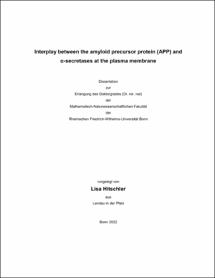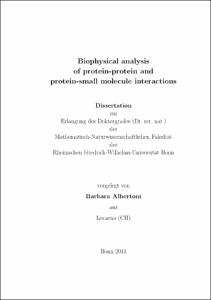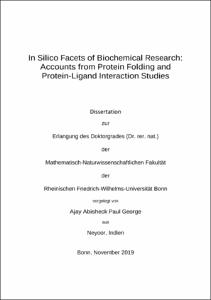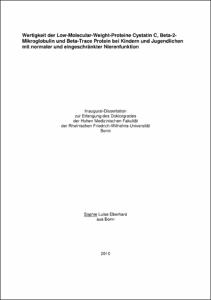Hitschler, Lisa: Interplay between the amyloid precursor protein (APP) and α-secretases at the plasma membrane. - Bonn, 2022. - Dissertation, Rheinische Friedrich-Wilhelms-Universität Bonn.
Online-Ausgabe in bonndoc: https://nbn-resolving.org/urn:nbn:de:hbz:5-66110
Online-Ausgabe in bonndoc: https://nbn-resolving.org/urn:nbn:de:hbz:5-66110
@phdthesis{handle:20.500.11811/9760,
urn: https://nbn-resolving.org/urn:nbn:de:hbz:5-66110,
author = {{Lisa Hitschler}},
title = {Interplay between the amyloid precursor protein (APP) and α-secretases at the plasma membrane},
school = {Rheinische Friedrich-Wilhelms-Universität Bonn},
year = 2022,
month = apr,
note = {Alzheimer’s disease (AD) is the most common form of dementia. A principle pathological feature of AD are senile plaques consisting of extracellular aggregations of amyloid β peptides (Aβ). Aβ is derived from the amyloid precursor protein (APP) that forms tight clusters composed of 20 – 30 molecules in the plasma membrane. In the amyloidogenic cleavage pathway, Aβ is generated by sequential cleavages, involving first a β-secretase followed by a ỿ-secretase complex.
On the other hand, Aβ is precluded upon APP cleavage at the cell surface by α-secretases. Yet, it is unkown what are the limiting factors in α-processing. Enhancement of α-secretase activity may be possible by either increasing the accessibility of the substrate, presumably limited through APP clustering, or after having gained a deeper understanding of the substrate-secretase interaction. These strategies could be the basis for therapeutic approaches to reduce Aβ generation and as a result treat the progression of Alzheimer’s disease.
We tested the hypothesis that pathogenic mutants are more prone to β-secretase cleavage because they are more tightly clustered and therefore less accessible to α-secretases. For clarification, epifluorescence microscopy and fluorescence recovery after photobleaching (FRAP) were utilized to examine the clustering degree and mobility of familial APP mutants. However, APP mutants behaved similarly as wild-type APP.
Next, we studied the proximity and physical interaction of APP and the α-secretases ADAM10 and ADAM17. Although ADAM10 is the predominant constitutive α-secretase, both secretases were found to be organized in individual nanodomains and located with equal frequency closer than 50 nm to their substrate APP. However, antibody-induced cross-linking of APP in the native membrane revealed a physical interaction of APP with ADAM10 but not with ADAM17, which might indicate a higher binding affinity of ADAM10 explaining its predominant role. More specifically, the transmembrane domain of APP was required for the physical interaction as well as for α-processing. The interaction with α-secretases was not enhanced when utilizing phorbol esters for stimulation of α-cleavage. The secretase interaction was also not altered with APP mutants carrying familial mutations in the Aβ region.
In conclusion, the substrate APP and the α-secretases ADAM10 and ADAM17 are organized in nanodomains close to each other. The here identified physical link between APP and ADAM10 might explain its predominat role as α-secretase. These results contribute to a more detailed understanding of the APP-enzyme interaction. Further research on the identification of parameters regulating this interaction could be beneficial in the future for therapeutic approaches to stimulate APP processing by α-secretases and as a result decrease Aβ generation.},
url = {https://hdl.handle.net/20.500.11811/9760}
}
urn: https://nbn-resolving.org/urn:nbn:de:hbz:5-66110,
author = {{Lisa Hitschler}},
title = {Interplay between the amyloid precursor protein (APP) and α-secretases at the plasma membrane},
school = {Rheinische Friedrich-Wilhelms-Universität Bonn},
year = 2022,
month = apr,
note = {Alzheimer’s disease (AD) is the most common form of dementia. A principle pathological feature of AD are senile plaques consisting of extracellular aggregations of amyloid β peptides (Aβ). Aβ is derived from the amyloid precursor protein (APP) that forms tight clusters composed of 20 – 30 molecules in the plasma membrane. In the amyloidogenic cleavage pathway, Aβ is generated by sequential cleavages, involving first a β-secretase followed by a ỿ-secretase complex.
On the other hand, Aβ is precluded upon APP cleavage at the cell surface by α-secretases. Yet, it is unkown what are the limiting factors in α-processing. Enhancement of α-secretase activity may be possible by either increasing the accessibility of the substrate, presumably limited through APP clustering, or after having gained a deeper understanding of the substrate-secretase interaction. These strategies could be the basis for therapeutic approaches to reduce Aβ generation and as a result treat the progression of Alzheimer’s disease.
We tested the hypothesis that pathogenic mutants are more prone to β-secretase cleavage because they are more tightly clustered and therefore less accessible to α-secretases. For clarification, epifluorescence microscopy and fluorescence recovery after photobleaching (FRAP) were utilized to examine the clustering degree and mobility of familial APP mutants. However, APP mutants behaved similarly as wild-type APP.
Next, we studied the proximity and physical interaction of APP and the α-secretases ADAM10 and ADAM17. Although ADAM10 is the predominant constitutive α-secretase, both secretases were found to be organized in individual nanodomains and located with equal frequency closer than 50 nm to their substrate APP. However, antibody-induced cross-linking of APP in the native membrane revealed a physical interaction of APP with ADAM10 but not with ADAM17, which might indicate a higher binding affinity of ADAM10 explaining its predominant role. More specifically, the transmembrane domain of APP was required for the physical interaction as well as for α-processing. The interaction with α-secretases was not enhanced when utilizing phorbol esters for stimulation of α-cleavage. The secretase interaction was also not altered with APP mutants carrying familial mutations in the Aβ region.
In conclusion, the substrate APP and the α-secretases ADAM10 and ADAM17 are organized in nanodomains close to each other. The here identified physical link between APP and ADAM10 might explain its predominat role as α-secretase. These results contribute to a more detailed understanding of the APP-enzyme interaction. Further research on the identification of parameters regulating this interaction could be beneficial in the future for therapeutic approaches to stimulate APP processing by α-secretases and as a result decrease Aβ generation.},
url = {https://hdl.handle.net/20.500.11811/9760}
}









